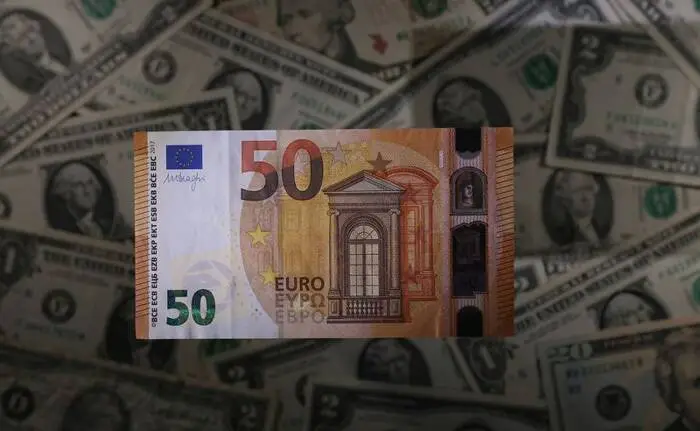简体中文
繁體中文
English
Pусский
日本語
ภาษาไทย
Tiếng Việt
Bahasa Indonesia
Español
हिन्दी
Filippiiniläinen
Français
Deutsch
Português
Türkçe
한국어
العربية
Currency markets calm, euro-dollar steady ahead of U.S. inflation data
Abstract:The Aussie and Kiwi dollars were trading near multi-week highs on Thursday as investors turned more bullish on risk assets such as equities while the dollar held in a narrow range ahead of U.S. inflation data due later in the day.

Currency market moves were small on Thursday as investors waited for key data on U.S. inflation to give clues on the Federal Reserves policy tightening trajectory.
Investors appetite for riskier assets has been hurt so far this year by expectations that the U.S. Federal Reserve will begin tightening monetary policy, starting with a rate hike at its March meeting.
Strong earnings helped global stocks rise on Wednesday, but they struggled to maintain this momentum during the Asian and early European sessions on Thursday.
Markets were focused on U.S. inflation data due later in the session. The headline consumer price index is expected to have increased more than 7% in January, year-on-year, a level reminiscent of the inflation shocks of the 1970s and 1980s.
“The higher the current inflation rates the stronger the perception is likely to be amongst market participants that the Fed will have to act even faster, more decisively and for a prolonged period of time than is currently expected,” wrote Commerzbank FX and EM analyst Antje Praefcke in a client note.
“That in turn is likely to provide a boost for the dollar.”
At 0825 GMT, the dollar index was down by less than 0.1% on the day, at 95.503. After large swings in the previous two weeks, it was on track for a minimal weekly change so far this week.
Investors are pricing in a 71% chance of the Fed hiking rates by 0.25 basis points at its March meeting, with as many as five rate hikes priced in for the year overall. [IR/PR].
Expectations that the European Central Bank would be slower to hike, as policymakers have been less concerned about inflation, generally kept euro-dollar subdued. But this changed last week when the ECB took a more hawkish stance at its meeting, prompting euro-dollar to jump to a three-week high of $1.1483.
At 0831 GMT, the euro was at $1.1428, little changed on the day. European government bond yields continued to edge higher, having surged last week following what analysts labelled as the ECBs “pivot”.
The Australian dollar, which is seen as a liquid proxy for risk appetite, was up 0.1% at $0.71875, while the New Zealand dollar was also a touch higher.
Also suggesting some appetite for risk, the Japanese yen hit a one-month low versus the dollar.
The Swedish crown was a touch lower against the dollar and euro after the Swedish central bank kept policy plans broadly unchanged, stressing that surging inflation is temporary and that it remains too early to begin withdrawing support from the economy even as the effects of the COVID pandemic fade.
In cryptocurrencies, bitcoin was around $44,260, in its third consecutive week of gains. But it remains far below the all-time high of $69,000 it hit last November.

Disclaimer:
The views in this article only represent the author's personal views, and do not constitute investment advice on this platform. This platform does not guarantee the accuracy, completeness and timeliness of the information in the article, and will not be liable for any loss caused by the use of or reliance on the information in the article.
Read more

Will the Euro and US Dollar Reach Parity in 2025?
Euro-dollar parity sparks debate again as 2025 approaches, with multiple factors shaping the exchange rate outlook.

US Dollar Surge Dominates Forex Market
The global forex market continues to show volatility, with the U.S. dollar fluctuating last week but overall maintaining a strong upward trend. How long can this momentum last?

Oil Prices Soar for 5 Days: How Long Will It Last?
Last week, the global oil market saw a strong performance, with Brent crude and WTI crude prices rising by 2.4% and around 5% respectively. Oil prices have now posted five consecutive days of gains. But how long can this rally last?

How Big is the Impact of the USD-JPY Rate Gap on the Yen?
The U.S. Federal Reserve's repeated rate cuts and the narrowing of the U.S.-Japan interest rate differential are now in sight. So, why is the U.S.-Japan interest rate differential so important for the yen’s safe-haven appeal, especially when global economic uncertainty rises?
WikiFX Broker
Latest News
Bitcoin in 2025: The Opportunities and Challenges Ahead
BI Apprehends Japanese Scam Leader in Manila
Join the Event & Level Up Your Forex Journey
Is There Still Opportunity as Gold Reaches 4-Week High?
Bitcoin miner\s claim to recover £600m in Newport tip thrown out
Good News Malaysia: Ready for 5% GDP Growth in 2025!
Breaking News! Federal Reserve Slows Down Interest Rate Cuts
Beware: Pig Butchering Scam Targeting Vulnerable Individuals
This Economic Indicator Sparks Speculation of a Japan Rate Hike!
Dutch Law Student Arrested for €4.5 Million Crypto Scam
Currency Calculator






